Abstract
Two clones (7a, virulent; 64d, attenuated) of a recombinant influenza virus (A/PR/8/34-A/ENGLAND/939/69 (H3N2)) were inactivated at the same rate by viral inhibitors present in nasal washes taken from both Clone 7a- and Clone 64d-infected ferrets. Both clones induced similar levels of interferon in the nasal washes of infected animals. The onset and rise of interferon production occurred at the same time for both clones, and was associated with a decline in virus titres. In addition, both clones showed a similar sensitivity to interferon. Thus, although nonspecific inhibitors and interferon may play a role in reducing nasal tract infection caused by both clones, the differences in virulence of the 2 clones do not appear to be determined by differential induction of, or resistance to, these host defence mechanisms.
Full text
PDF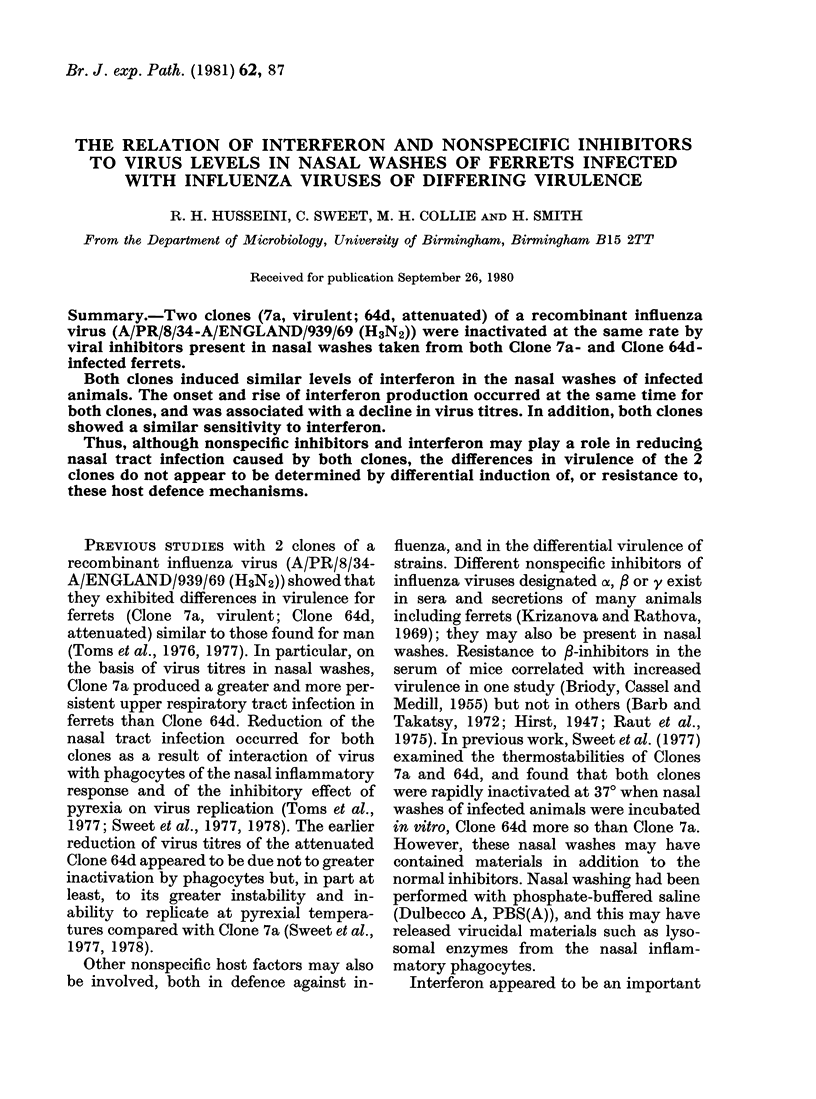
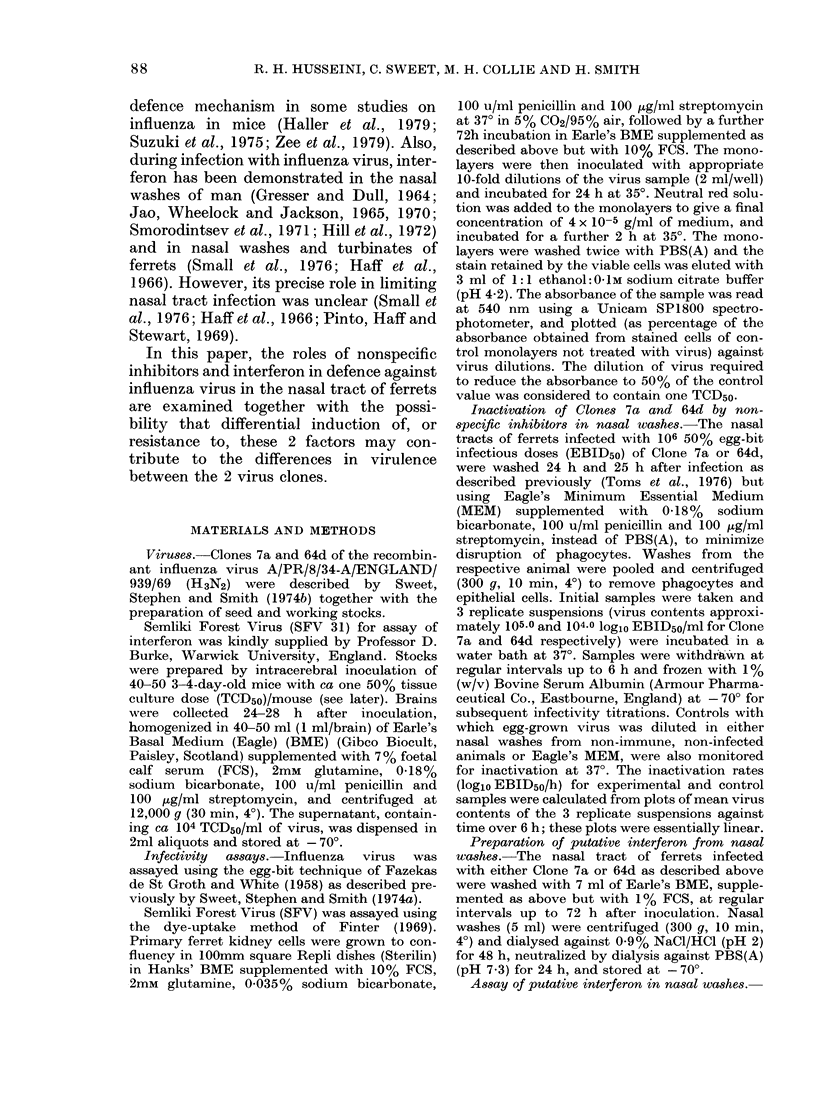
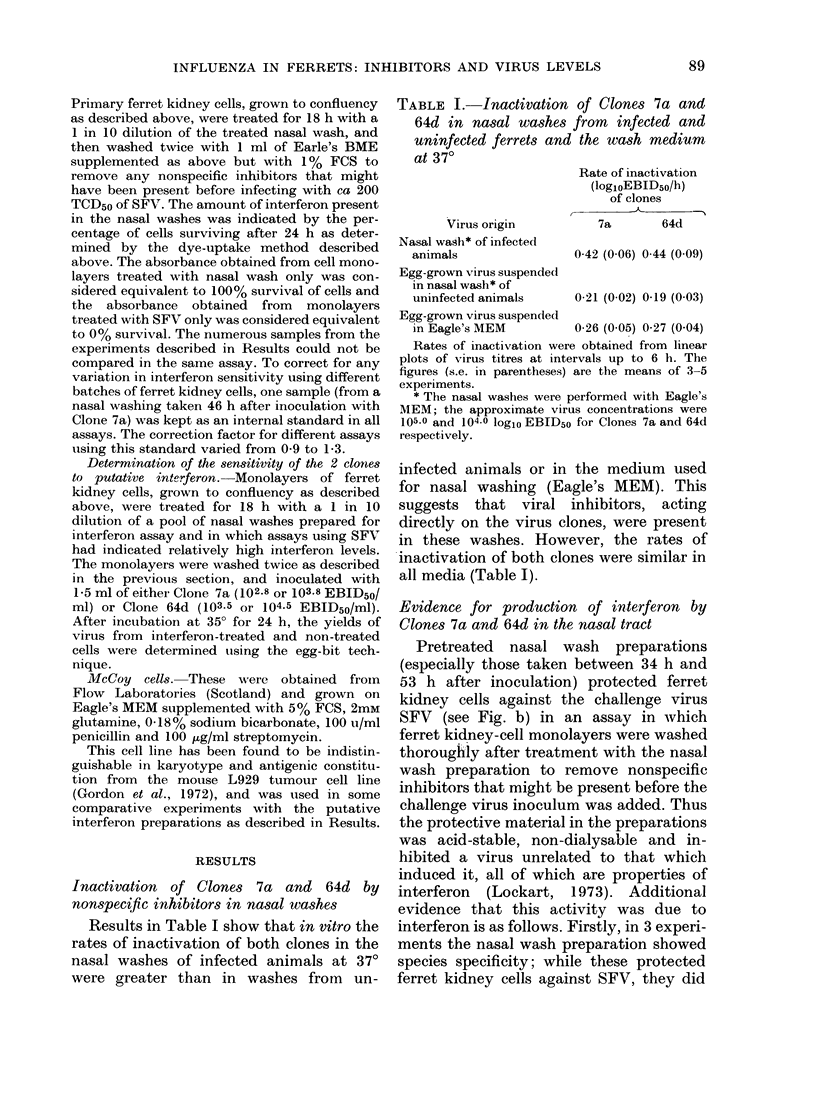
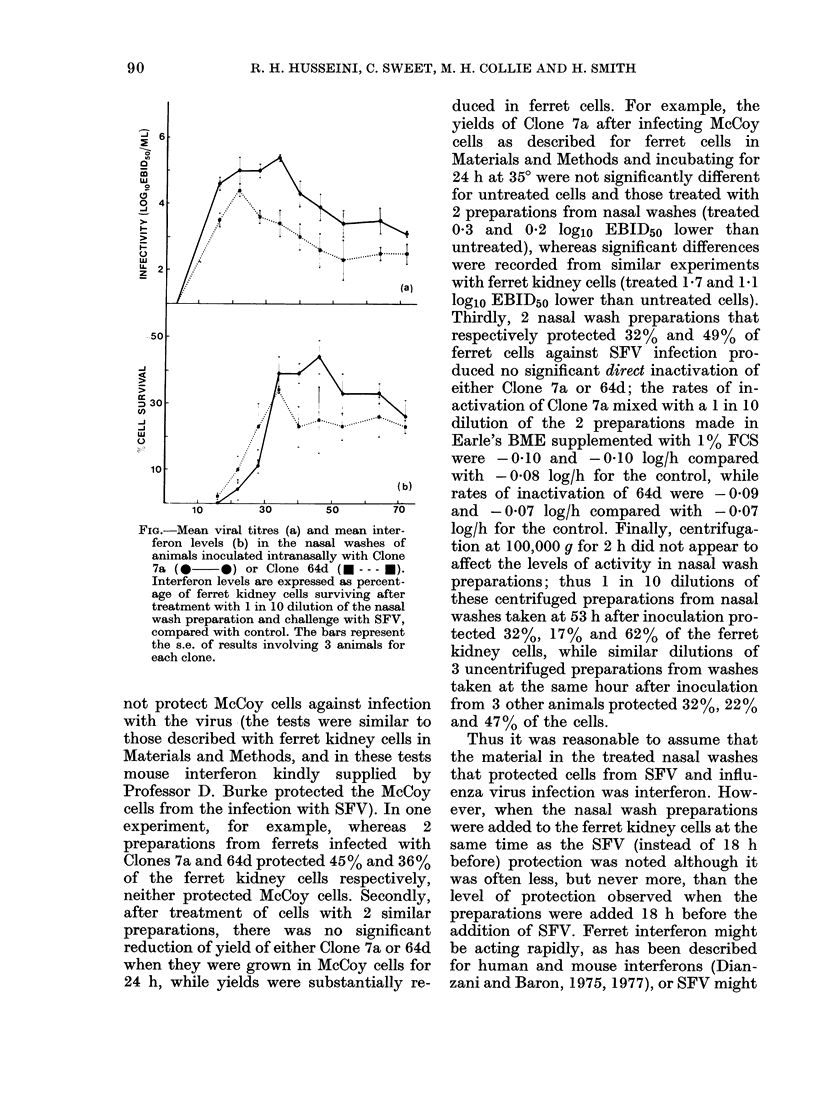
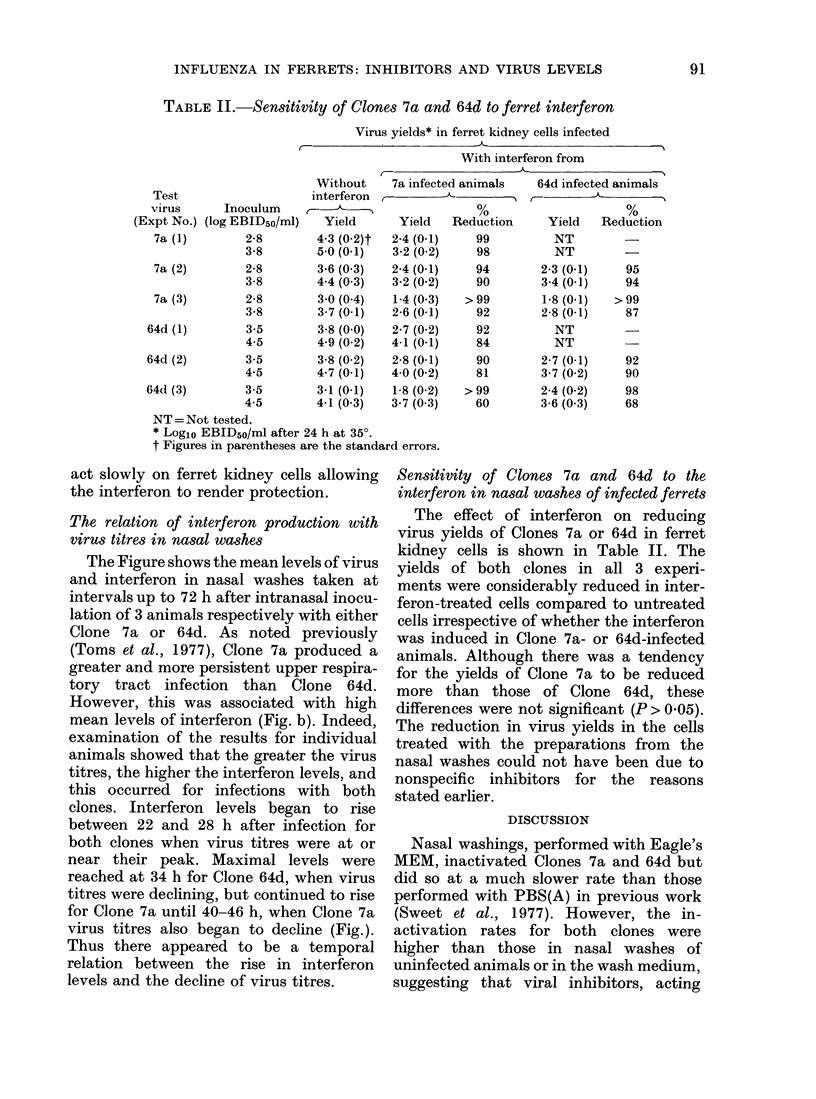
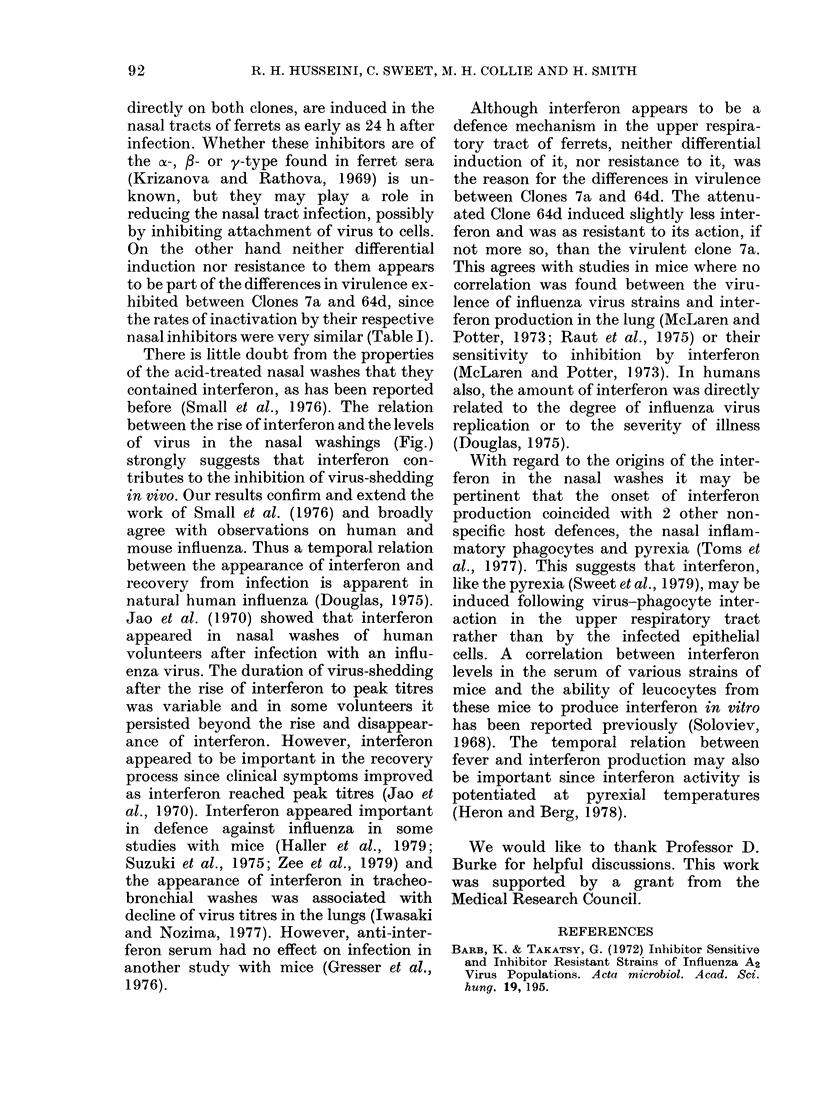
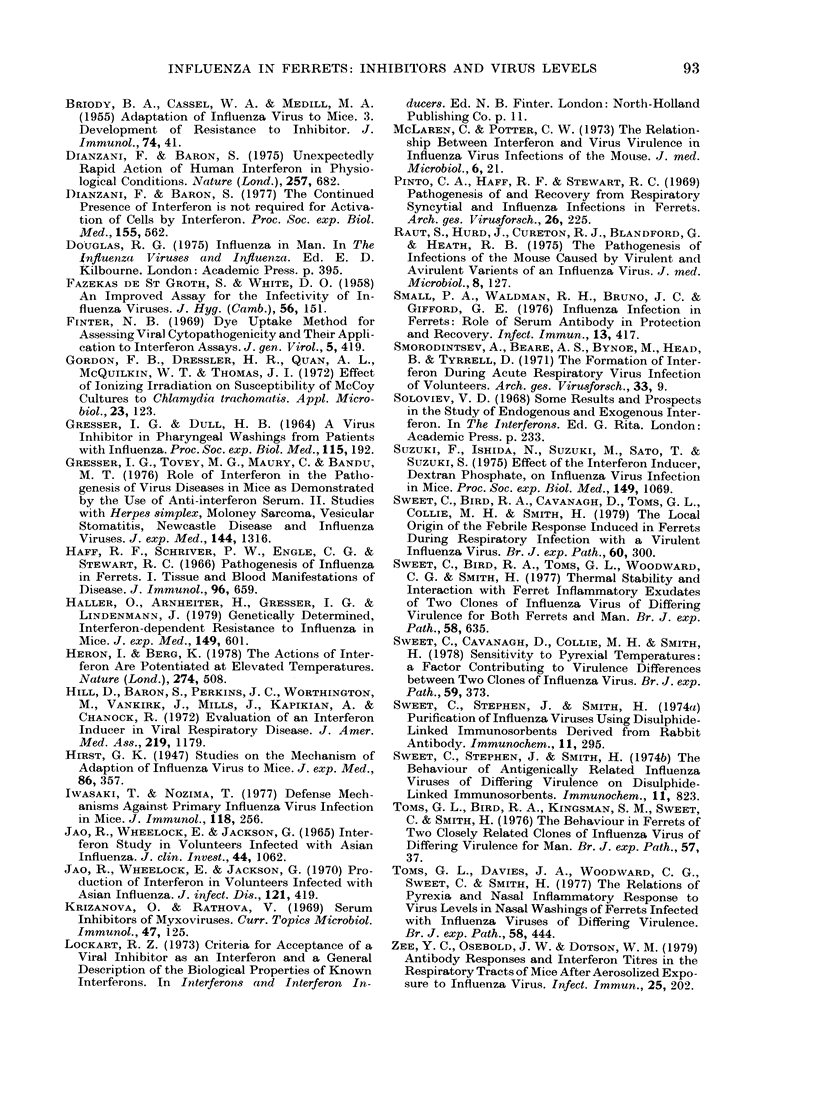
Selected References
These references are in PubMed. This may not be the complete list of references from this article.
- BRIODY B. A., CASSEL W. A., MEDILL M. A. Adaptation of influenza virus to mice. III. Development of resistance to beta inhibitor. J Immunol. 1955 Jan;74(1):41–45. [PubMed] [Google Scholar]
- Barb K., Takátsy G. Inhibitor-sensitive and inhibitor-resistant influenza A2 virus populations. Acta Microbiol Acad Sci Hung. 1972;19(3):195–205. [PubMed] [Google Scholar]
- Dianzani F., Baron S. The continued presence of interferon is not required for activation of cells by interferon. Proc Soc Exp Biol Med. 1977 Sep;155(4):562–566. doi: 10.3181/00379727-155-39851. [DOI] [PubMed] [Google Scholar]
- Dianzani F., Baron S. Unexpectedly rapid action of human interferon in physiological conditions. Nature. 1975 Oct 23;257(5528):682–684. doi: 10.1038/257682a0. [DOI] [PubMed] [Google Scholar]
- FAZEKAS DE ST GROTH S., WHITE D. O. An improved assay for the infectivity of in influenza viruses. J Hyg (Lond) 1958 Mar;56(1):151–162. doi: 10.1017/s0022172400037621. [DOI] [PMC free article] [PubMed] [Google Scholar]
- GRESSER I., DULL H. B. A VIRUS INHIBITOR IN PHARYNGEAL WASHINGS FROM PATIENTS WITH INFLUENZA. Proc Soc Exp Biol Med. 1964 Jan;115:192–196. doi: 10.3181/00379727-115-28867. [DOI] [PubMed] [Google Scholar]
- Gordon F. B., Dressler H. R., Quan A. L., McQuilkin W. T., Thomas J. I. Effect of ionizing irradiation on susceptibility of McCoy cell cultures to Chlamydia trachomatis. Appl Microbiol. 1972 Jan;23(1):123–129. doi: 10.1128/am.23.1.123-129.1972. [DOI] [PMC free article] [PubMed] [Google Scholar]
- Gresser I., Tovey M. G., Maury C., Bandu M. T. Role of interferon in the pathogenesis of virus diseases in mice as demonstrated by the use of anti-interferon serum. II. Studies with herpes simplex, Moloney sarcoma, vesicular stomatitis, Newcastle disease, and influenza viruses. J Exp Med. 1976 Nov 2;144(5):1316–1323. doi: 10.1084/jem.144.5.1316. [DOI] [PMC free article] [PubMed] [Google Scholar]
- Haff R. F., Schriver P. W., Engle C. G., Stewart R. C. Pathogenesis of influenza in ferrets. I. Tissue and blood manifestations of disease. J Immunol. 1966 Apr;96(4):659–667. [PubMed] [Google Scholar]
- Haller O., Arnheiter H., Gresser I., Lindenmann J. Genetically determined, interferon-dependent resistance to influenza virus in mice. J Exp Med. 1979 Mar 1;149(3):601–612. doi: 10.1084/jem.149.3.601. [DOI] [PMC free article] [PubMed] [Google Scholar]
- Heron I., Berg K. The actions of interferon are potentiated at elevated temperature. Nature. 1978 Aug 3;274(5670):508–510. doi: 10.1038/274508a0. [DOI] [PubMed] [Google Scholar]
- Hill D. A., Baron S., Perkins J. C., Worthington M., Van Kirk J. E., Mills J., Kapikian A. Z., Chanock R. M. Evaluation of an interferon inducer in viral respiratory disease. JAMA. 1972 Feb 28;219(9):1179–1184. [PubMed] [Google Scholar]
- Iwasaki T., Nozima T. Defense mechanisms against primary influenza virus infection in mice. I. The roles of interferon and neutralizing antibodies and thymus dependence of interferon and antibody production. J Immunol. 1977 Jan;118(1):256–263. [PubMed] [Google Scholar]
- Jao R. L., Wheelock E. F., Jackson G. G. Production of interferon in volunteers infected with Asian influenza. J Infect Dis. 1970 Apr;121(4):419–426. doi: 10.1093/infdis/121.4.419. [DOI] [PubMed] [Google Scholar]
- Krizanová O., Rathová V. Serum inhibitors of myxoviruses. Curr Top Microbiol Immunol. 1969;47:125–151. doi: 10.1007/978-3-642-46160-6_6. [DOI] [PubMed] [Google Scholar]
- Pinto C. A., Haff R. F., Stewart R. C. Pathogenesis of and recovery from respiratory syncytial and influenza infections in ferrets. Arch Gesamte Virusforsch. 1969;26(3):225–237. doi: 10.1007/BF01242375. [DOI] [PubMed] [Google Scholar]
- Raut S., Hurd J., Blandford G., Heath R. B., Cureton R. J. The pathogenesis of infections of the mouse caused by virulent and avirulent variants of an influenza virus. J Med Microbiol. 1975 Feb;8(1):127–136. doi: 10.1099/00222615-8-1-127. [DOI] [PubMed] [Google Scholar]
- Small P. A., Jr, Waldman R. H., Bruno J. C., Gifford G. E. Influenza infection in ferrets: role of serum antibody in protection and recovery. Infect Immun. 1976 Feb;13(2):417–424. doi: 10.1128/iai.13.2.417-424.1976. [DOI] [PMC free article] [PubMed] [Google Scholar]
- Smorodintsev A. A., Beare A. S., Bynoe M. L., Head B., Tyrrell D. A. The formation of interferon during acute respiratory virus infection of volunteers. Arch Gesamte Virusforsch. 1971;33(1):9–16. doi: 10.1007/BF01254158. [DOI] [PubMed] [Google Scholar]
- Suzuki F., Ishida N., Suzuki M., Sato T., Suzuki S. Effect of the interferon inducer, dextran phosphate, on influenza virus infection in mice. Proc Soc Exp Biol Med. 1975 Sep;149(4):1069–1075. doi: 10.3181/00379727-149-38960. [DOI] [PubMed] [Google Scholar]
- Sweet C., Bird R. A., Cavanagh D., Toms G. L., Collie M. H., Smith H. The local origin of the febrile response induced in ferrets during respiratory infection with a virulent influenza virus. Br J Exp Pathol. 1979 Jun;60(3):300–308. [PMC free article] [PubMed] [Google Scholar]
- Sweet C., Bird R. A., Toms G. L., Woodward C. G., Smith H. Thermal stability and interaction with ferret inflammatory exudates of two clones of influenza virus of differing virulence for both ferrets and man. Br J Exp Pathol. 1977 Dec;58(6):635–643. [PMC free article] [PubMed] [Google Scholar]
- Sweet C., Cavanagh D., Collie M. H., Smith H. Sensitivity to pyrexial temperatures: a factor contributing to virulence differences between two clones of influenza virus. Br J Exp Pathol. 1978 Aug;59(4):373–380. [PMC free article] [PubMed] [Google Scholar]
- Sweet C., Stephen J., Smith H. The behaviour of antigenically related influenza viruses of differing virulence on disulphide-linked immunosorbents. Immunochemistry. 1974 Dec;11(12):823–826. doi: 10.1016/0019-2791(74)90304-8. [DOI] [PubMed] [Google Scholar]
- Toms G. L., Bird R. A., Kingsman S. M., Sweet C., Smith H. The behaviour in ferrets of two closely related clones of influenza virus of differing virulence for man. Br J Exp Pathol. 1976 Feb;57(1):37–48. [PMC free article] [PubMed] [Google Scholar]
- Toms G. L., Davies J. A., Woodward C. G., Sweet C., Smith H. The relation of pyrexia and nasal inflammatory response to virus levels in nasal washings of ferrets infected with influenza viruses of differing virulence. Br J Exp Pathol. 1977 Aug;58(4):444–458. [PMC free article] [PubMed] [Google Scholar]
- Zee Y. C., Osebold J. W., Dotson W. M. Antibody responses and interferon titers in the respiratory tracts of mice after aerosolized exposure to influenza virus. Infect Immun. 1979 Jul;25(1):202–207. doi: 10.1128/iai.25.1.202-207.1979. [DOI] [PMC free article] [PubMed] [Google Scholar]


